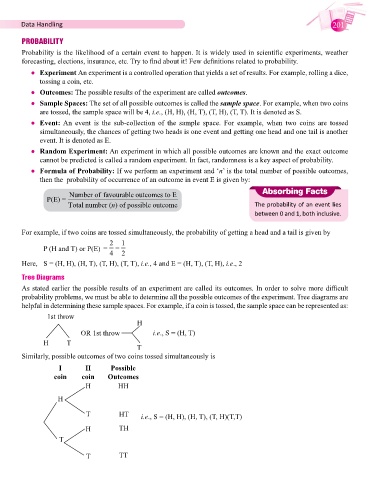Page 203 - Maths Skills - 8
P. 203
Data Handling 201
PROBABILITY
Probability is the likelihood of a certain event to happen. It is widely used in scientific experiments, weather
forecasting, elections, insurance, etc. Try to find about it! Few definitions related to probability.
● Experiment An experiment is a controlled operation that yields a set of results. For example, rolling a dice,
tossing a coin, etc.
● Outcomes: The possible results of the experiment are called outcomes.
● Sample Spaces: The set of all possible outcomes is called the sample space. For example, when two coins
are tossed, the sample space will be 4, i.e., (H, H), (H, T), (T, H), (T, T). It is denoted as S.
● Event: An event is the sub-collection of the sample space. For example, when two coins are tossed
simultaneously, the chances of getting two heads is one event and getting one head and one tail is another
event. It is denoted as E.
● Random Experiment: An experiment in which all possible outcomes are known and the exact outcome
cannot be predicted is called a random experiment. In fact, randomness is a key aspect of probability.
● Formula of Probability: If we perform an experiment and ‘n’ is the total number of possible outcomes,
then the probability of occurrence of an outcome in event E is given by:
Absorbing Facts
Number of favourable outcomestoE
P(E) =
Total number () of possn i ible outcome The probability of an event lies
between 0 and 1, both inclusive.
For example, if two coins are tossed simultaneously, the probability of getting a head and a tail is given by
P (H and T) or P(E) = 2 = 1
4 2
Here, S = (H, H), (H, T), (T, H), (T, T), i.e., 4 and E = (H, T), (T, H), i.e., 2
Tree Diagrams
As stated earlier the possible results of an experiment are called its outcomes. In order to solve more difficult
probability problems, we must be able to determine all the possible outcomes of the experiment. Tree diagrams are
helpful in determining these sample spaces. For example, if a coin is tossed, the sample space can be represented as:
1st throw
H
OR 1st throw i.e., S = (H, T)
H T
T
Similarly, possible outcomes of two coins tossed simultaneously is
I II Possible
coin coin Outcomes
H HH
H
T HT i.e., S = (H, H), (H, T), (T, H)(T,T)
H TH
T
T TT

